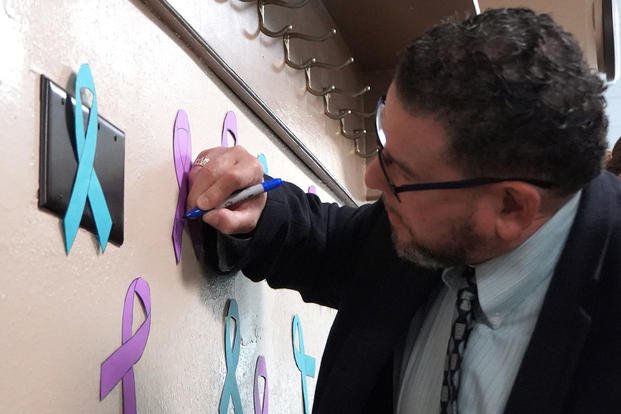A study of veterans who served after Sept. 11, 2001, shows that suicide rates have dropped significantly since 2020, a finding researchers say “gives some hope” that efforts to battle suicide among former service members are working.
Scientists with the University of Texas at San Antonio, the Uniformed University of Health Sciences, and the Veterans Affairs Salt Lake City Health Care System reviewed national mortality data from 2006 to 2022 and found that, while veteran suicide rates increased steadily from 2006 to 2020, they dropped from 2020 to 2022.
According to the data, for vets with a history of traumatic brain injury, the rate declined by 12% each year from 2020 through 2022, and for vets with no diagnosis of a head injury, dipped by 7.5% each year.
Read Next: Navy Demotion Reversed for GOP Congressman Who Government Watchdog Found Abused Subordinates
A trend analysis showed that suicide rates among veterans increased from 2006 to 2011 but then rose at a slower rate until 2020, when the rates began to decline. By contrast, rates among the general U.S. population showed a different pattern, increasing from 2006 to 2018, dipping from 2018 to 2020, and rising again from 2020 to 2022.
Lead researcher Jeffrey Howard, a professor at the University of Texas at San Antonio Department of Public Health, said it was important to look at the cohort of post-9/11 veterans because he had examined the population in 2023 and found not only were rates significantly higher among veterans, but there was a disturbing upward trend in the number of deaths.
The reversal, Howard said, came as a “surprise.”
“So much [of a surprise] that I ran everything multiple times just to make sure I didn’t make a mistake somewhere, but that is what the data show,” Howard said in an interview Thursday.
According to the report, published Wednesday in JAMA Network Open, of the 2.5 million veterans reviewed, 9,667 died by suicide. The rates for veterans with traumatic brain injury reached a peak of roughly 100 suicides per 100,000 person-years and declined to just below 70 per 100,000 person-years in 2022.
For veterans without a history of TBI, the rate in 2020 was 61 per 100,000 person-years; in 2022, the rate had declined to 42 per 100,000.
Person-hours are used in research to understand populations across time. A “person-year” is calculated by multiplying the number of people in a study by the time each person has spent in the study. So while the review looked at 2.5 million veterans, it did so across their lives for 16 years, or more than 23 million person-hours.
The study ends with 2022 because that is the most recent year data is available on deaths in the United States.
The data continues to show that suicide rates among veterans, and especially those with head injuries, remain exceedingly high. In 2020, the rate among the comparable U.S. population was roughly 19 per 100,000 person-years; by 2022, it was slightly over 20 per 100,000 person-years.
The findings are more dramatic than the downward trend identified by the Department of Veterans Affairs in its 2024 National Veteran Suicide Prevention annual report, which examined deaths in 2022. That review found that, from 2021 to 2022, the suicide rate among veterans aged 18 to 34 dropped by 3.8%, while the rate for veterans aged 35 to 54 held steady.
The recent research excluded veterans who may not have sought care in the military health system or at the VA and may include deaths that were not properly identified as suicides, limitations that may contribute to the discrepancy.
But Howard said the research is important because it may indicate “a turn of the tide” against veteran suicide. He added that government programs, including the VA’s Prevention 2.0 Initiative, which assists health providers in treating veterans with suicidal behavior, and the President’s Roadmap to Empower Veterans, or PREVENTS, program, introduced by President Donald Trump in 2020, that promotes community partnerships, public awareness and safe storage of firearms, may be contributing.
“Evaluation of these potential impacts is critical as the government considers budget cuts to VA programs,” the researchers wrote.
VA Secretary Doug Collins has said he favors addressing veteran suicide by partnering with community organizations to tackle the problem at the grassroots level. During a hearing on the fiscal 2026 VA budget in May, he said he was “not satisfied” with the VA’s response to the problem.
“We have added $588 million every year for the last few years to veterans suicide prevention. It’s not working,” Collins said. “So, I want to use grants and programs like this to reach out beyond the scope of where we’re currently reaching.”
The VA in May announced the opening of the application process for the department’s Staff Sgt. Parker Gordon Fox Suicide Prevention Grant Program, which will provide $52.5 million to community organizations that provide suicide prevention programs or emergency services for at-risk veterans.
The department is expected to select awardees by Sept. 30.
Related: They Said the Rise in Military Suicide Is a Mystery. Traumatic Brain Injury May Be an Answer.
Story Continues
Read the full article here

